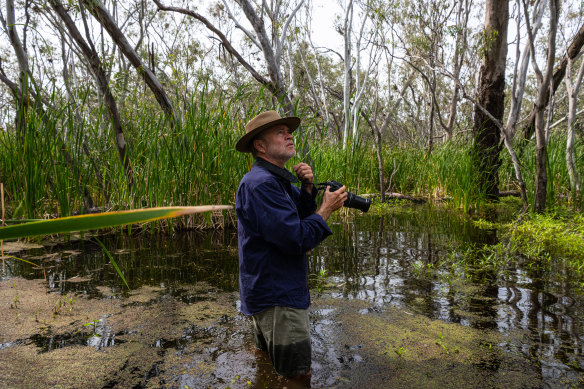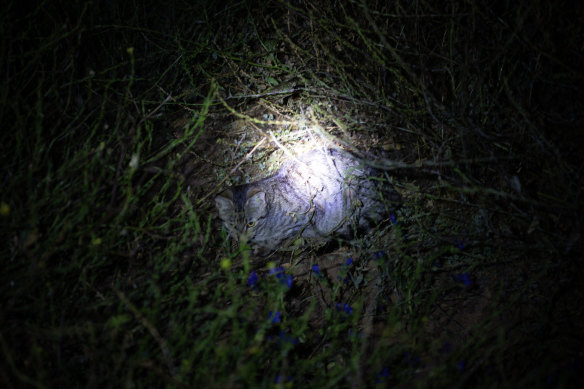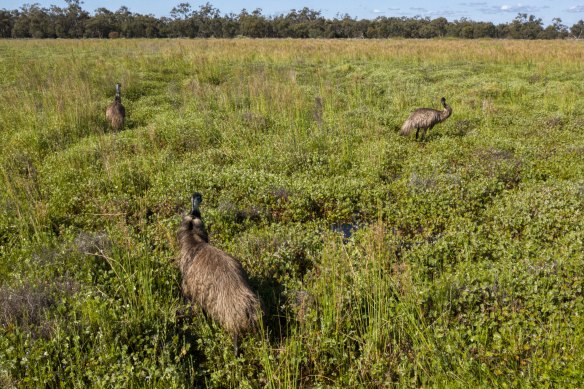
Biologist Sophie Hewitt is gunning an army green, eight-wheeled amphibious vehicle not much larger than a quad bike across boot-sucking mud and pools of chest-deep water.
We’re closing in on a distant burble that sounds like highway traffic. But it can’t be; we’re in the Macquarie Marshes, north-west of Dubbo, surrounded by 200,000 hectares of flooded wetland.
Dodging trunks of inundated coolibah trees and giant tangles of vine-like lignum, we get close enough to send up a drone. The video feed reveals the sound’s source: a vast colony of honking, flapping, foraging straw-necked ibis. In each nest, on islands of lignum, are the specks of white eggs.
These thousands-strong waterbird breeding events are part of the reason the Macquarie Marshes are an internationally recognised Ramsar-listed wetland (Ramsar is an international convention for protection of wetlands.)
“There’s undoubtedly a full-on breeding season happening,” Hewitt’s PhD supervisor, ecologist Professor Richard Kingsford, says. “Because there’s so much water in the system, there’ll be a lot of colonies and they’ll go for a long time, which is pretty unusual. It’s just a frenzy, basically.”
This could be the most spectacular year in the marshes in three decades. The question is how far three back-to-back La Nina events and this year’s record rain will go in restoring a wetland constricted by dams, scorched by record drought and threatened by climate change.
Hewitt, Kingsford, biologists from the Australian Museum and a gaggle of ecology students from UNSW have slipped into the marshes for a 36-hour window between flood pulses to help find out.
Between 2017 and 2019, the marshes were sapped by the driest three years on record. River red gums died and dried to bone-white. In an aerial survey, Kingsford spotted a single pair of black ducks sitting in dusty, crackle-dry reed beds.
Now, Kingsford estimates that at least 500,000 megalitres, equivalent to the water held in Sydney Harbour, has gushed across the system. Between 200,000 and 400,000 megalitres usually kick off a major breeding event. It feels like every inch of the wetlands is soaked and thrumming with life.
Later, we wade into a forest of river red gums. Every fork is stuffed with a loose assemblage of twigs frizzed with eucalyptus leaves: the nests of rare, nocturnal night herons. Kingsford, who has studied the marshes for 37 years, hasn’t seen them in the marshes for six years.

Professor Richard Kingsford has studied the Macquarie Marshes and led waterbird surveys across Australia for 37 years.Credit:Nick Moir
A whistling kite is raiding the nests for unguarded chicks. Behind us, a rakali wends through the slow-moving water (a native water rat - picture an aquatic ringtail possum). Deeper into the trees are a few thousand breeding egrets.
Back at the road, students are recording sightings of pacific herons with 1.5-metre wingspans, emus ushering clusters of striped chicks across the floodplain, royal spoonbills crowned in their breeding plumage and the fluorescent blue-green flash of mallee ringneck parrots. The marshes also support endangered species including the Australasian bittern and painted snipe.
“For a frog biologist, it has been absolutely heaven. I have never seen so many frogs in my life.”
Dr Jodi Rowley on the current state of the Macquarie Marshes
At night, we find broad-palmed rocket frogs, named for their turbocharged leap, and salmon-striped frogs, which sport pink eyeshadow. Frog biologist Dr Jodi Rowley points out cattle prints in the mud where spotted marsh frogs have laid their frothy eggs.
She’s hoping to find a bucket-list species: the elusive underground holy cross frog. It looks as if Fabergé bedazzled a lemon and only emerges during downpours.
“For a frog biologist, it has been absolutely heaven,” Rowley says. “I have never seen so many frogs in my life.”
Aim your torch at the sky, and the reason for this explosion of life reveals itself: the static of moths, midges and mosquitoes is thick enough to blot out the Milky Way. Plunge a net into a roadside puddle and it will come out wriggling with tadpoles, mosquito larvae, water beetles and finger-length predatory dragonfly nymphs armed with spring-loaded retractable jaws. Every litre of soil can squirm with up to 10,000 microcrustaceans.
These invertebrates are the “engine room” of biodiversity in the marshes, says Kingsford.
“I find it almost intoxicating to be able to go out into that environment and see how much is happening,” he says. “But the scientist in me wants to look at the data and see how it compares to where this place has been in the past.”
The marshes once spanned a million hectares before the construction of the Burrendong Dam on the Macquarie River, which feeds the marshes, in 1967. The marshes constricted to one-fifth of their former size as water was diverted to irrigators (cotton is the primary crop in the marshes). The wetlands once flooded every two years. After the dam, it’s more like every five years.
The number of waterbird nests in the marshes has plunged by 11,000 every 11 years since the dam’s construction. In 2016, a big flood year, Kingsford counted 30,000 nests - a disappointing number. But the NSW environment and heritage group estimates there were 90,000 nests by February 2022. They estimate that number could have climbed to 150,000.
The number of nests counted over summer this year will give crucial insight into just how resilient this boom-and-bust ecosystem really is.

The spawning insects are the critical “engine room” of the food web that supports the frogs and bird life in the Macquarie Marshes.Credit:Nick Moir
“The marshes used to come back like a super ball, and bounce back to the same height every time you had a big flood event,” says Kingsford. “But now I think of these bounces as being like a tennis ball - the bounces aren’t as high as they used to be.
“That will be the really interesting thing to me. How big a bounce have we got out of this one?”
Climate change will sap the marshes of more water in coming years but, for the time being, water extraction is the main reason for the marshes’ downward trend. In 2009, the government notified Ramsar that the Macquarie Marshes were degrading from a semi-permanent wetland to an ephemeral wetland.
Last year, ANU analysis found Australia risked breaching the Ramsar pact due to convoluted water management and lack of obligation to meet and report on conservation goals.
In 2018, then water minister David Littleproud slashed the water recovery target in the northern basin by 70 gigalitres, putting further pressure on the marshes. The move was later described by the Murray Darling basin royal commission as “deplorable” and “unlawful”. In 2020 ICAC warned the NSW government’s water regulation had been “overly favourable to irrigators” and that the Department of Primary Industries had focused on irrigators while restricting information available to environmental agencies.
Dr Celine Steinfeld, director of the Wentworth Group of Concerned Scientists, is out at the marshes. She’s a critic of the “credit” system used by the river operators, whereby inflows to the dam are predicted based on past rainfall charts and water is allocated to users before the rain actually falls.
In 2019, the predicted rain didn’t come. The dam was at 4.7 per cent. In August, flows to the Macquarie River were shut off. In October, 3000 hectares of the marshes burned.
Steinfeld says the rainfall that year “was worse than what was previously recorded,” which foiled a system based on historical rain records. “It all goes out the window with climate change,” she says.

The higher water levels offer greater protection to waterbird colonies from feral cats and pigs in the marshes.Credit:Nick Moir
It was the same year the royal commission warned that the plan ignored the potentially “catastrophic” effects of climate change. The river was dry for over a year.
Garry Hall, a beef farmer whose family has run cattle on their property in the marshes for nearly 90 years, describes the credit model as “archaic”.
He’s also concerned that floodplain harvesting laws, which would regulate the amount of floodwater irrigators can divert when water flows onto their land, isn’t going far enough to protect downstream flows.
“We need [floodplain water] licensed,” Garry says. “But we’ve got to get it right. There’s no good issuing licences that in three to five years, taxpayers have to go and buy back because there were mistakes made.”

Emus splash through flooded grasslands.Credit:Nick Moir
Proposed floodplain harvesting laws have been blocked three times in the NSW senate over concerns they don’t protect enough environmental water or downstream communities. But Environment Minister James Griffin signed off on water sharing plans that allow floodplain harvesting in two northern basin catchments, and the government plans to do the same in the Macquarie Valley next year.
Loading
In a statement, a spokesman for NSW water minister Kevin Anderson said, “This reform will benefit water users, downstream communities, and the environment, with up to 100 billion litres of water to be returned to the floodplains in the northern river valleys each year.”
The government’s own modelling shows the laws would only improve environmental water flows by 0.2 per cent each year in the Macquarie Valley.
“Who’s in government for this next term will either secure the future of the wetlands and the downstream communities that depend on the river, or continue the disgraceful decline of the wetlands,” says Garry.
Get to the heart of what’s happening with climate change and the environment. Our fortnightly Environment newsletter brings you the news, the issues and the solutions. Sign up here.









 Add Category
Add Category